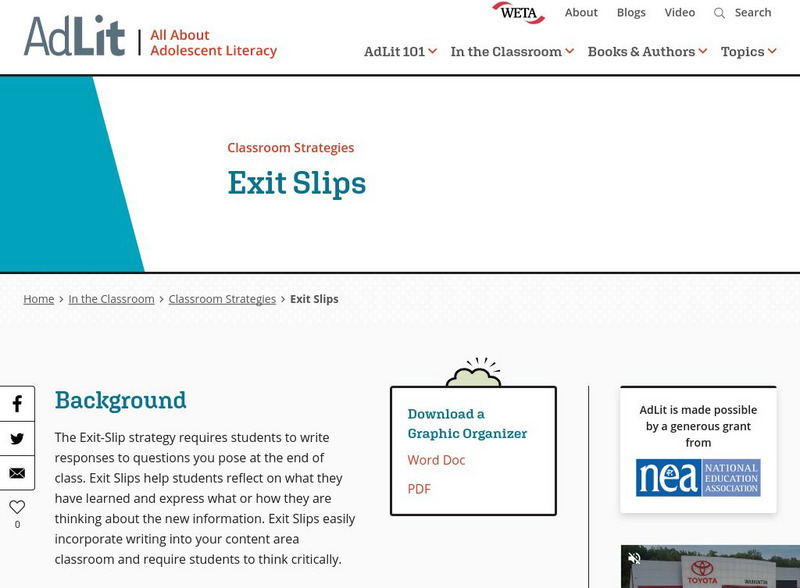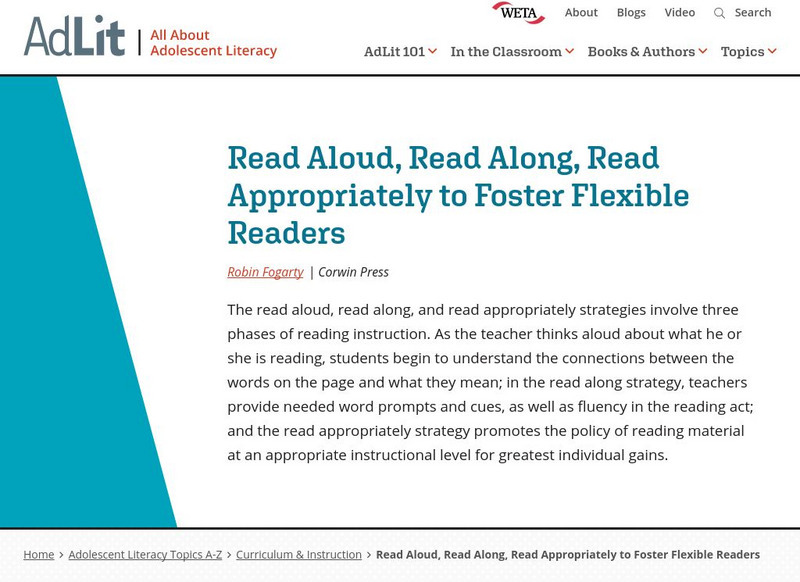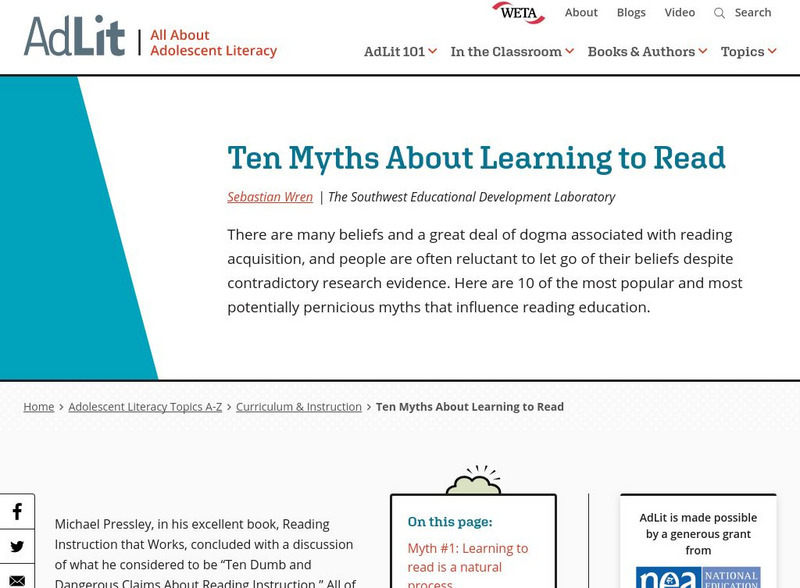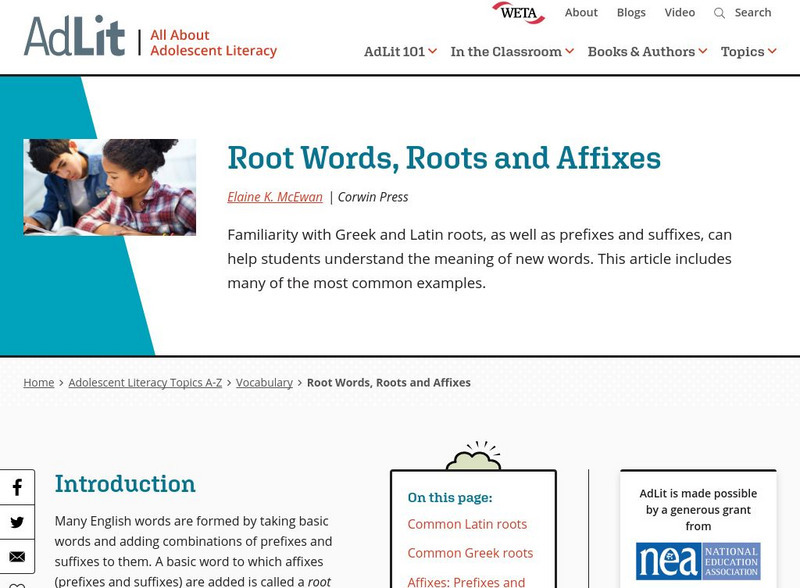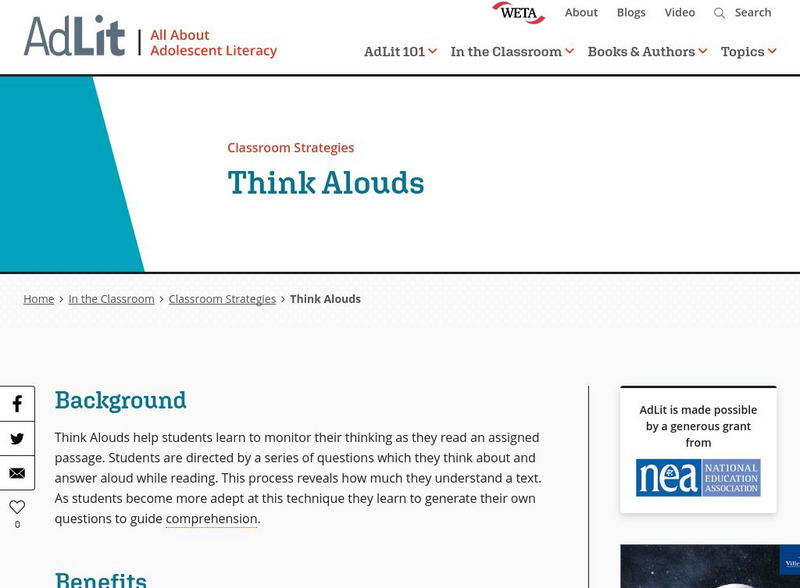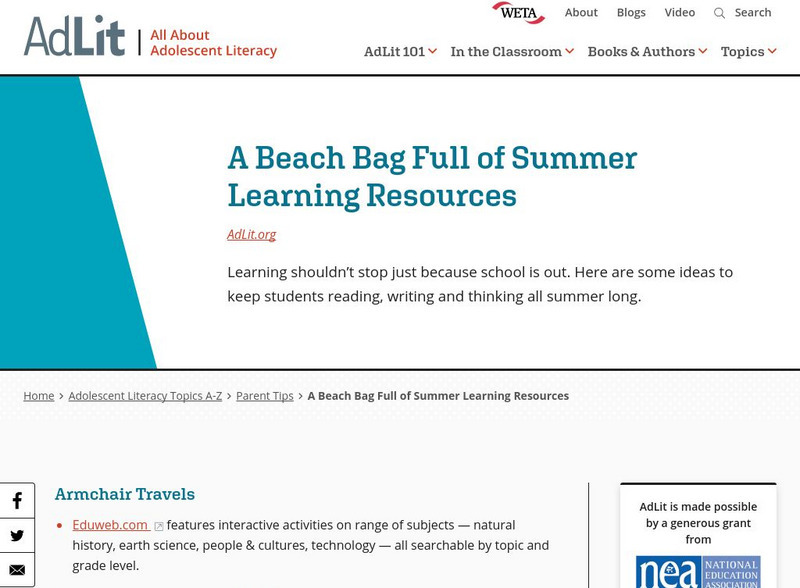AdLit
Ad lit.org: Classroom Strategies: Power Notes
Power Notes is a strategy that teaches students an efficient form of organizing information from assigned text. This technique provides students a systematic way to look for relationships within material they are reading. Power Notes...
AdLit
Ad lit.org: Classroom Strategies: Exit Slips
The Exit-Slip strategy requires students to write responses to questions you pose at the end of class. Exit Slips help students reflect on what they have learned and express what or how they are thinking about the new information. Exit...
AdLit
Ad lit.org: Scaffold Mindful Silent Reading
Help students internalize and routinize their reading comprehension monitoring with this sample lesson.
AdLit
Ad lit.org: The Teaching Moves of a Strategic Teacher
Research demonstrates the effectiveness of the 12 strategic teaching moves described in this article. On any given day in any given classroom, the strategic teacher employs all of these moves - whether with the whole class, a small...
AdLit
Ad lit.org: Reading (And Scaffolding) Expository Texts
To help students comprehend expository text structures, teachers can acquaint them with the signal or cue words authors utilize in writing each of the structures and use the graphic organizers offered in this article
AdLit
Ad lit.org: Read Aloud, Read Along, Read Appropriately to Foster Flexible Readers
The read aloud, read along, and read appropriately strategies involve three phases of reading instruction. As the teacher thinks aloud about what he or she is reading, students begin to understand the connections between the words on the...
AdLit
Ad lit.org: Explicit Comprehension Strategy Instruction
Use explicit strategy instruction to make visible the invisible comprehension strategies that good readers use to understand text. Support students until they can use the strategies independently. Recycle and re-teach strategies...
AdLit
Ad lit.org: Grouping Students Who Struggle With Reading
There are a variety of grouping formats that have been proven effective for teaching reading to students with learning disabilities: whole class, small group, pairs, and one-on-one. This article summarizes the research and implications...
AdLit
Ad lit.org: Ten Myths About Learning to Read
There are many beliefs and a great deal of dogma associated with reading acquisition, and people are often reluctant to let go of their beliefs despite contradictory research evidence. Here are 10 of the most popular and most potentially...
AdLit
Ad lit.org: Reading Software: Finding the Right Program
With the range and variety of commercial software products on the shelves today, how can an educator or parent choose a program that will most benefit a particular student? Where are product reviews that can inform the decision?
AdLit
Ad lit.org: Dyslexia and High School
An expert shares her observations of a dyslexic student struggling to learn at school. Also included are numerous proven examples of differentiated instruction and accommodations that can help a student to succeed.
AdLit
Ad lit.org: The Why, When, What, and How of Disclosure in a Postsecondary
When you continue your studies after high school, should you tell the school and instructors about your learning disability? This article will help you decide when and how to disclose your disability to obtain accommodations.
AdLit
Ad lit.org: Root Words, Roots and Affixes
Familiarity with Greek and Latin roots, as well as prefixes and suffixes, can help students understand the meaning of new words. This article includes many of the most common examples.
AdLit
Ad lit.org: Tips for Reading Tutors
The U.S. Department of Education developed this brief guide for reading tutors. It lists ways that tutoring helps both the learner and the tutor, and provides practical tips that can help tutors be more effective in their work.
AdLit
Ad lit.org: Teach Vocabulary by Building Background Knowledge
Students need to develop an extensive vocabulary to read with fluency. In turn, fluency in reading leads to increased comprehension. Fluency also comes from the written language of the reader since the student writes words he or she...
AdLit
Ad lit.org: Some Obstacles to Vocabulary Development
A strong vocabulary, both written and spoken, requires more than a dictionary. In fact, it requires an educational commitment to overcoming four obstacles: the size of the task (the number of words students need to learn is exceedingly...
AdLit
Ad lit.org: The Clarifying Routine: Elaborating Vocabulary Instruction
The more a new vocabulary word is associated with ideas from students' own experience, the more likely the word will become well 'networked' and a permanent part of memory. Making these links involves elaborating definitions of new...
AdLit
Ad lit.org: Classroom Strategies: Think Alouds
Think Alouds help students learn to monitor their thinking as they read an assigned passage. Students are directed by a series of questions which they think about and answer aloud while reading. This process reveals how much they...
AdLit
Ad lit.org: Classroom Strategies: Double Entry Journals
The Double-Entry Journal strategy enables students to record their responses to text as they read. Students write down phrases or sentences from their assigned reading and then write their own reaction to that passage. The purpose of...
AdLit
Ad lit.org: Classroom Strategies: Monitoring/clarifying
The Monitoring/Clarifying strategy teaches students to recognize when they don't understand parts of a text and to take necessary steps to restore meaning. This technique is a component of the Reciprocal Teaching model in which teachers...
AdLit
Ad lit.org: Classroom Strategies: Paired Reading
The Paired Reading strategy encourages peer teaching and learning. Students are divided into pairs and read along together or take turns reading aloud to each other. Pairs can have the same reading ability or can include a more fluent...
AdLit
Ad lit.org: Classroom Strategies: Paragraph Shrinking
Paragraph Shrinking is an activity developed as part of the Peer-Assisted Learning Strategies (PALS). PALS is a classwide peer tutoring program in which teachers carefully partner a student with a classmate. The Paragraph Shrinking...
AdLit
Ad lit.org: What Are the Key Elements of Student Engagement?
As part of their series to help schools understand the federal No Child Left Behind Law, Learning Point Associates describes the four key elements of student engagement - student confidence, teacher involvement, relevant texts, and...
AdLit
Ad lit.org: A Beach Bag Full of Summer Learning Resources
Learning shouldn't stop just because school is out. Here are some ideas to keep students reading, writing and thinking all summer long.

